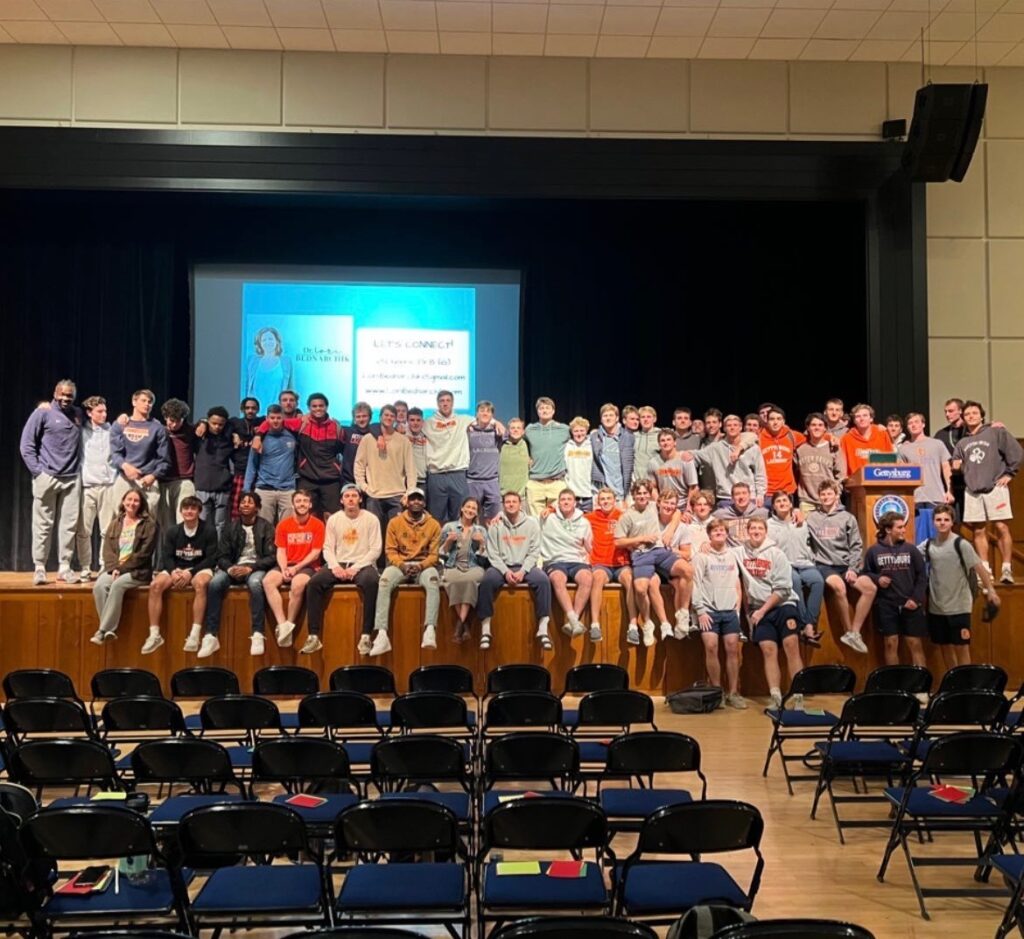The Office of Sexual Respect and Title IX Hosts “Wanna Make Out?” A Conversation About Consent
By Ella Prieto, Staff Writer

On Sept. 29 the Office of Sexual Respect and Title IX hosted Dr. Lori Bednarchik for a conversation about consent as a part of their It’s On Us Week of Action.
Bednarchik is a leading expert on consent and communication in the country and has a Ph.D. in Human Communication from Arizona State University, an MPH in Health Education and Health Promotion, and a B.A. in English and Gender Studies from University of Maryland. She offers a new perspective to the conversation surrounding consent, offering what to do in consent discussions instead of what not to do. This approach is known as an affirmative standard of consent and was the topic of Bednarchik’s presentation.
The audience for the presentation consisted of several men’s sports teams, including the lacrosse and basketball teams.
Men’s basketball team member Chase Morgan ’24 explained that the team likes to “get involved on campus as much as [they] can.”
Director of the Office of Sexual Respect and Title IX Amanda Blaugher first introduced Bednarchik, mentioning her background and various accomplishments. Bednarchik then took over, setting up a slide show to go along with her speech.
She began by explaining the benefits of consent, breaking them down into six categories: relationships, communication, self-esteem, safer sex practices, mutual pleasure, and sexual activity. These benefits were then brought up throughout the presentation as Bednarchik described affirmative consent and the five characteristics of it.
She said that affirmative consent focuses on “yes” and what “yes” looks like, so that when engaged in a sexual act, an individual can understand how their partner is feeling and if they are comfortable. She noted that being more sex positive is more effective.
Bednarchik broke down the five characteristics of affirmative consent into continuous, freely given, specific, informed, and enthusiastic. She then elaborated on each of these characteristics with stories and definitions.
Continuous refers to the fact that consent must be given throughout a sexual act. It often goes together with communication, as continuous communication is a way to ensure continuous consent. Bednarchik explained that as you get further into a relationship, how you communicate this continuous consent may look different. For a fresh relationship or new hookup, however, verbal confirmation that sexual activity is okay and enjoyed is vital.
Consent also must be freely given. This means that there is absolutely no manipulation involved in asking for a sexual act. She noted that manipulation can include using a power imbalance or asking if a person is sure that they do not want to partake in a sexual act multiple times. Both add serious pressure to the person being asked and do not allow for true consent to be given.
Bednerchik also added, “No is a complete sentence.”
She stated that when someone says “no,” it should automatically be respected rather than twisted to try and create a “yes.” Furthermore, the person you want to engage in sexual activities with should not be severely under the influence of any substance. Even if a person says “yes,” their mind is distorted and cannot give full consent.
Next, consent must be specific. A person who agrees to one sexual act may not want to participate in another, and you should never expect a sexual partner to always be open to sexual acts.
“Saying ‘yes’ to one thing does not imply ‘yes’ to another,” explained Bednerchik.
Informed was the next characteristic of affirmative consent. Bednerchik elaborated that there should be no lying or deceiving in sexual acts and that you should always ask questions of your sexual partner. This includes getting tested for sexually transmitted diseases (STDs) and infections (STIs). Being informed and giving information to your sexual partners allows both of you to stand on even footing and have safe and consensual sex.
Blaugher then stepped in to explain to students ways to get tested for STDs and STIs on campus. Students can learn more about the process of STD and STI testing at the college here. Blaugher also clarified that you can get tested at Planned Parenthood in York as well. Their testing procedures are here.
The final characteristic of affirmative consent was enthusiastic, which Bednerchik described as her favorite one. This means that consent is an explicit, powerful “yes,” not merely an absence of no. When a partner is ready to engage in sexual activity and comfortable in doing so, they will be enthusiastic in giving their consent.
To conclude her presentation Bednerchik tested the audience with some questions. Audience members were given red, yellow, and green cards to signal their answers to these questions about consent. Red meant stop, yellow meant yield and have a conversation with your partner, and green meant to go ahead with the act but continue to check in with your partner, as consent is continuous.
At the end of the presentation, Bednerchik reviewed what she discussed and thanked the audience for their engagement.
